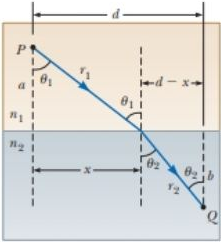
Concept explainers
Pierre de Fermat (1601–1665) showed that whenever light travels from one point to another, its actual path is the path that requires the smallest time interval. This statement is known as Fermat’s principle. The simplest example is for light propagating in a homogeneous medium. It moves in a straight line because a straight line is the shortest distance between two points. Derive Snell’s law of refraction from Fermat’s principle. Proceed as follows. In Figure P34.54, a light ray travels from point P in medium 1 to point Q in medium 2. The two points are, respectively, at perpendicular distances a and b from the interface. The displacement from P to Q has the component d parallel to the interface, and we let x represent the coordinate of the point where the ray enters the second medium. Let t = 0 be the instant the light starts from P. (a) Show that the time at which the light arrives at Q is
(b) To obtain the value of x for which t has its minimum value, differentiate t with respect to x and set the derivative equal to zero. Show that the result implies
(c) Show that this expression in turn gives Snell’s law.
Figure P34.54 Problems 54 and 55.

(a)
To show: The time at which the light arrives at Q is
Answer to Problem 35.84CP
Explanation of Solution
The given figure is shown below.

Figure (1)
In right angle triangle PAB,
In right angle triangle BCQ,
The time taken by light to travel from point P to Q is,
Here,
The expression for refractive index is,
Substitute
Substitute
Substitute
Conclusion:
Therefore, the time at which the light arrives at Q is
(b)
To show: The result
Answer to Problem 35.84CP
Explanation of Solution
Apply the condition of maxima and minima,
Substitute
Conclusion:
Therefore, the result
(c)
To show: The expression of Snell’s law,
Answer to Problem 35.84CP
Explanation of Solution
In right angle triangle PAB,
Similarly, in right angle triangle BCQ,
Substitute,
Conclusion:
Therefore, the expression of Snell’s law is
Want to see more full solutions like this?
Chapter 35 Solutions
Physics for Scientists and Engineers, Technology Update (No access codes included)
- Figure P23.28 shows a curved surface separating a material with index of refraction n1 from a material with index n2. The surface forms an image I of object O. The ray shown in red passes through the surface along a radial line. Its angles of incidence and refraction are both zero, so its direction does not change at the surface. For the ray shown in blue, the direction changes according to n1 sin 1 = n2 sin 2. For paraxial rays, we assume 1 and 2 are small, so we may write n1 tan 1 n2 tan 2. The magnification is defined as M = h/h. Prove that the magnification is given by M = n1q/n2p. Figure P23.28arrow_forwardWhile looking into your beverage, you notice that the straw appears bent where it enters the water's surface. If the angle your eyes make with the normal to the water is 65.0 degrees, what angle does the straw appear to be bent at? answer choices a)42.8 degrees b)95.2 degrees c)65.0 degrees d)45.0 degreesarrow_forwardUsing filters, a physicist has created a beam of light consisting of three wavelengths: 400 nm (violet), 500 nm (green), and 650 nm (red). She aims the beam so that it passes through air and then enters a block of crown glass. The beam enters the glass at an incidence angle of θ1 = 31.6°. The glass block has the following indices of refraction for the respective wavelengths in the light beam. wavelength (nm) 400 500 650 index of refraction n400 nm = 1.53 n500 nm = 1.52 n650 nm = 1.51 (a) Upon entering the glass, are all three wavelengths refracted equally, or is one bent more than the others? 400 nm light is bent the most500 nm light is bent the most 650 nm light is bent the mostall colors are refracted alike (b) What are the respective angles of refraction (in degrees) for the three wavelengths? (Enter each value to at least two decimal places.) (i) θ400 nm ° (ii) θ500 nm ° (iii) θ650 nm °arrow_forward
- During a demonstration of fiber optics, Mr. H uses an acrylic light pipe to demonstrate total internal reflection for light as it navigates its way through a curved medium, entering at one end and exitting at the other with very little loss of light along the way.a. If the acrylic has an index of refraction of 1.48, then determine its critical angle when surrounded by air.b. Determine the critical angle of the acrylic light pipe when surrounded by water (n=1.33).arrow_forwardThe top of a swimming pool is at ground level. If the pool is 2.30 m deep, how far below ground level does the bottom of the pool appear to be located for the following conditions? (The index of refraction of water is 1.333.) (a) The pool is completely filled with water. answer in m below ground level (b) The pool is filled halfway with water. answer in m below ground levelarrow_forward
 Physics for Scientists and EngineersPhysicsISBN:9781337553278Author:Raymond A. Serway, John W. JewettPublisher:Cengage Learning
Physics for Scientists and EngineersPhysicsISBN:9781337553278Author:Raymond A. Serway, John W. JewettPublisher:Cengage Learning Physics for Scientists and Engineers with Modern ...PhysicsISBN:9781337553292Author:Raymond A. Serway, John W. JewettPublisher:Cengage Learning
Physics for Scientists and Engineers with Modern ...PhysicsISBN:9781337553292Author:Raymond A. Serway, John W. JewettPublisher:Cengage Learning College PhysicsPhysicsISBN:9781285737027Author:Raymond A. Serway, Chris VuillePublisher:Cengage Learning
College PhysicsPhysicsISBN:9781285737027Author:Raymond A. Serway, Chris VuillePublisher:Cengage Learning Principles of Physics: A Calculus-Based TextPhysicsISBN:9781133104261Author:Raymond A. Serway, John W. JewettPublisher:Cengage Learning
Principles of Physics: A Calculus-Based TextPhysicsISBN:9781133104261Author:Raymond A. Serway, John W. JewettPublisher:Cengage Learning College PhysicsPhysicsISBN:9781305952300Author:Raymond A. Serway, Chris VuillePublisher:Cengage Learning
College PhysicsPhysicsISBN:9781305952300Author:Raymond A. Serway, Chris VuillePublisher:Cengage Learning




